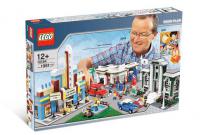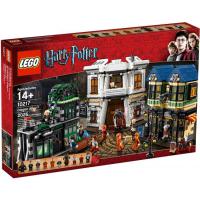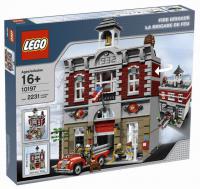

“Dark Age”: the period of time between when a person loses interest in LEGO and when they rediscover it as an adult.
It is not much of a surprise to say that the LEGO collecting, investing and reselling market is almost exclusively the domain of the adult fan of LEGO (AFOL). Without this key demographic, LEGO price guide and investment information websites like Brickpicker.com would not exist. Therefore, the forces that drive people in and out of the LEGO community are worth exploring and understanding as the size of the AFOL market will largely determine the value and worth of all past and future LEGO sets. With that in mind, I sometimes find myself trying to figure out the reasons that contributed to my LEGO Dark Ages in the 1990’s and then thankfully to a personal LEGO Renaissance in the 2000’s. As my experience is probably not unique, I began to think that the LEGO Dark Age phenomenon is not simply a case of shifting adult priorities or responsibilities. That is too simple an explanation. Generally speaking, I believe that there are three universal reasons that contributed to my Dark Ages and ultimate Renaissance that may also apply to many AFOL’s who entered their Dark Ages in the 1990’s only to find their Renaissance in the 2000’s.
The first Dark Age factor is a decline in quality, both materially and artistically. During the 1990’s LEGO quality seemed to decline quite a bit. Memorable sets were few and far between and most sets did not have any real adult appeal. Builds were overwhelmingly simple and uninspired. There was very little to attract the attention or entice anyone out of their LEGO Dark Age. You could count on one hand the number of sets that exceeded 1,000 pieces and even those sets lacked the intricate detail prized and craved by the AFOL of today. This artistic decline only consistently began to change after 2000. Set piece size count, playability, and intricate details greatly increased and allowed the creative aspect of LEGO quality to flourish, much like, well, a Renaissance. The Ultimate Collector's Series was born in 2000 with the release of the 7181 Tie Interceptor and 7191 X-Wing Fighter.
The iconic 3450 Statue of Liberty was also released in 2000, making it the largest LEGO set that was released up to that point.
One need only compare the Cloud City set (10123), that was released in 2003 with the Death Star (10188), released five years later, to get an idea of the strides that have been made in playability, even within a well-established hit theme such as Star Wars.
The advent of the “modular buildings” is a great example of the Renaissance in LEGO quality that began in the mid-2000’s and is still in full swing in 2012. This material and artistic revival has resulted in a remarkable jump in value for many of these quality vanguard sets like Café Corner (10182), Green Grocer (10185), Grand Carousel (10196), Eiffel Tower (10181), and Town Plan (10184) to name a few.
Just check out the current values below if you have any doubt:
Set # Set Name Year Released Pieces MSRP (US$) Current Price (US$) % Increase from MSRP 10182 Cafe Corner 2007 2056 139.99 1099 685% 10185 Green Grocer 2008 2352 149.99 548 265% 10196 Grand Carousel 2009 3263 249.99 667 167% 10181 Eiffel Tower 2007 3428 199.99 890 345% 10184 Town Plan 2008 1981 149.99 438 192% The second Dark Age factor is stagnation and lack of variety. There just were not that many themes or sets available for most of the 1990’s and what was available, lacked variety and gave the impression that LEGO was stagnating and offering nothing really innovative or dynamic. During much of the 1990’s the number of sets released each year hovered around the 200 mark, bottoming out with barely only 100 sets released in 1992! Again, there just was not a lot sets released to drag an AFOL out of their Dark Age. Of those sets from 1990, most were in the Pirates, Space, Town (City) and Castle themes, which were primarily geared towards younger children. It was not until 2002 that a year had more than 400 sets released. Starting in 2006 LEGO routinely released more than 400 sets a year, with some years having significantly more. Last year(2011) for example, saw nearly 600 sets released, including multiple licensed themes such as STAR WARS, Harry Potter and Pirates of the Caribbean and extremely popular non-licensed themes such as Ninjago and City/Town. This new found diversity and variety directly contributes to LEGO Renaissances for many AFOL’s and, more importantly, keeps them firmly committed to the LEGO hobby.
The final Dark Age factor is the general LEGO group lack of focus and direction. Beginning in the 1990’s LEGO seemed to be moving in many different directions at once and not particularly focused on their core expertise of making unsurpassed brick building toys. Considerable energy was diverted from this core value to establish the Legoland parks and to compete against the likes of Disney and Six Flags. The entrance into the video game market was yet another ancillary branch that took LEGO further from its core strength and diluted the core LEGO building toy concept. This is not to say that some of the video games were not good—some certainly were—but honestly, there are many, many more companies far superior to LEGO when it comes to video game publishing, and NONE that are superior to LEGO when it comes to creating brick building toys! Finally, there were countless ill-conceived LEGO lifestyle products that simply added nothing to the core LEGO strength and only served to blur the lines of the LEGO brand. LEGO is best when it does LEGO and that means brick building toys. There is room for other LEGO concepts just not to the extent that they take away from the basic LEGO core strength. After all, it is this core strength that ultimately allows the other concepts to exist. Stray too far from this universal truth and you risk losing LEGO fans to the Dark Ages.
The above reasons are by no means exhaustive on the subject and are really only an attempt to stimulate others to explore the forces that led them out and back into the LEGO collecting world. There is a fine line between a Dark Age and a Renaissance and no two AFOL’s journey is exactly the same. Many AFOL’s never had a dreaded Dark Ages, and for that they should consider themselves fortunate. However, now that LEGO is on strong creative footing, with seemingly endless themes to delight all ages and remains laser focused on the LEGO building experience, one can only imagine that there will be far fewer Dark Ages in the futures and many more Renaissances. Who knows, maybe the Dark Ages are on their way to extinction?
- Read more...
-
- 40 comments
- 5,740 views









